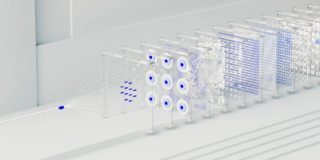Did you know 94% of a visitor’s first impression of your business is design-related? 75% of consumers judge a web development company’s credibility based on the website’s overall design. These numbers indicate that it is essential to have a great web design for building trust with potential customers.
With advancements in technologies and changing consumer behavior, businesses need to adapt to the latest web design trends to increase sales and stay ahead of their competitors.
Key Website Design Trends to Watch Out for In 2020
-
Dark Mode

Dark mode refers to the color scheme that uses a dark background and light text elements. This creates a higher contrast ratio while reducing eye strain.
Over the past few years, we have seen social apps like WhatsApp and Twitter, implementing dark mode. In 2020, we will see more websites following this trend.
-
Browser Machine Learning
Many companies are already using machine learning for various purposes, such as online fraud detection, predictive analytics, and virtual personal assistant.
However, in 2020 and the coming years, we will see websites leveraging machine learning to complete tasks within the browser itself. Some of them have already started doing it. Ajis is one such website that uses browser machine learning.
It consists of a collection of machine learning-powered JavaScript apps. The biggest benefit of browser machine learning is that users don’t need to send data to the server-side to get the tasks done, thereby promoting data privacy.
-
Split Screen In Content

Split-screen refers to dividing the webpage into different parts. The aspect ratio depends on the type of content on the page. For instance, eCommerce websites usually split the screen in a 1:1 ratio like the one shown in the image below.
With the increase in mobile users, split-screen is becoming an important part of web design. It enables you to divide the content into two different vertical blocks on small screens and deliver the message efficiently.
-
3D Digital Pictures
Websites that rely heavily on visuals to sell their products or services, such as eCommerce, architects, and video game developers, need 3D pictures to build trust and convert more customers.
It is highly unlikely that VR (virtual reality) will become mainstream in the next four-five years, owing to its high cost. However, with hyper-realistic 3D pictures, you can provide an immersive experience to your website visitors.
In times to come, we expect to see more websites using 3D web designs to break the boundaries between reality and digital space.
-
Inclusive Web Design
Inclusive web design is one of the biggest web design trends in 2020. The primary reason for this is that last year, the United States court said all the sites need to follow the W3C’s Web Content Accessibility Guidelines AA standard.
It means your website should be accessible to everyone, including those with disabilities. Your site must work properly even when someone uses screen readers to access your website’s content.
-
Digital Illustrations
Gone are the days when sites used to rely on stock photos to grab visitor’s attention. In 2020 and beyond, we will see websites leveraging digital illustrations to improve their overall design.
Illustrations give life to your thoughts and ideas. With relevant digital pictures, you can make your website stand out from the crowd and build an emotional connection with your visitors.

81% of marketers say video content has helped increase the average time visitors spend on their website. Besides, the demand for video content is constantly rising.
In the coming months, we will witness more websites implementing video headers to provide their users with an immersive experience as soon as they land on their homepage.
-
Privacy Protection
There’s a growing concern about privacy among internet users. Websites need to assure their visitors that their data is protected in the best possible ways.
It also includes refining your privacy policy. In other words, you should clearly highlight the data you collect and for what purposes in your privacy policy.
-
Full-screen Forms

Full-screen forms remove any potential distraction and encourage users to fill all the fields. Full-screen forms occupy more screen space, which makes it look smaller than it actually is. As a result, more customers are likely to fill the form.
In 2020, more developers are adding full-screen forms on their websites to increase the conversion rate.
Minimalist navigation is yet another web design trend that might change the way a website is designed. 94% of users say your site must be easy to navigate.
Websites now need to simplify their navigation as much as possible to ensure it could be navigated using voice. After all, voice is the future.
-
White Space

In 2020, websites have started using wide frames of white spaces to make the visuals shine.
White space improves the content readability drastically. If you have noticed, almost every website is now using white space to give their designs more structure and stability.
Another benefit of white spaces is that it helps visitors flow from one element to another so that they don’t miss anything from the whole.
Conclusion
Modern web design is all about capturing the user’s attention with dark mode, 3D digital pictures, split-screen, illustrations, videos, and white space. It also includes making the site accessible to everyone.
How many of these website trends have you already implemented? Did we miss any latest web design trends? Let us know in the comments!
Need Any Technology Assistance? Call Pursho @ 0731-6725516




